Smart Home Appliances Market Size
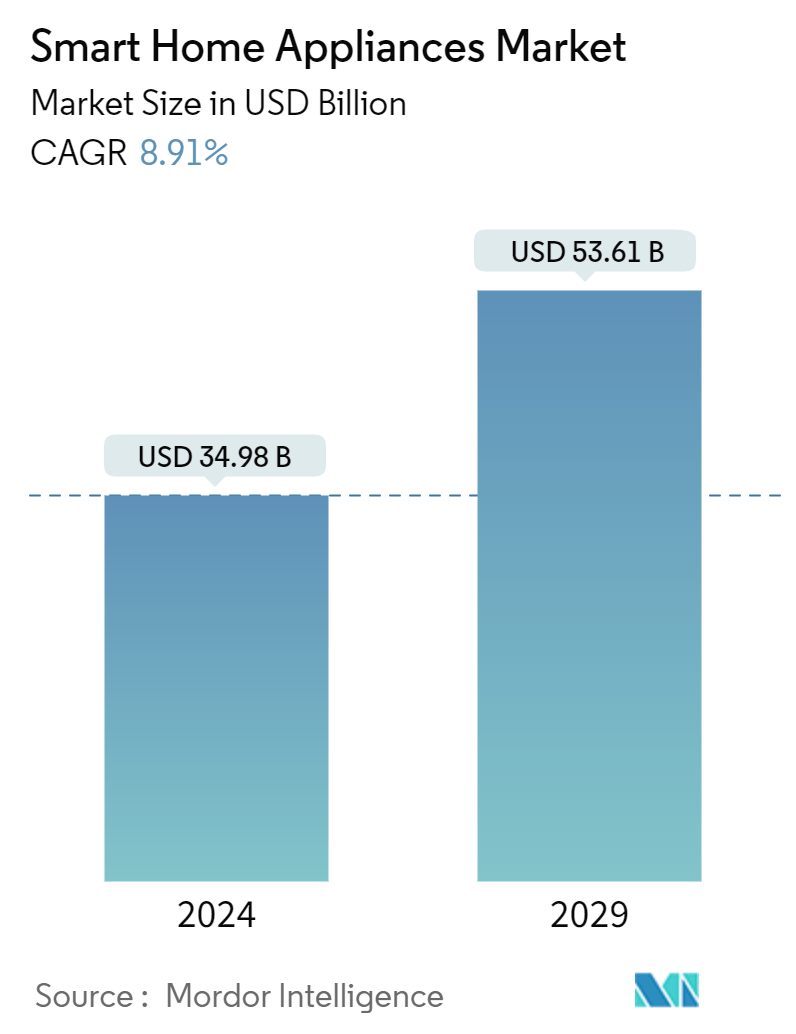
| Study Period | 2019 - 2029 |
| Market Size (2024) | USD 34.98 Billion |
| Market Size (2029) | USD 53.61 Billion |
| CAGR (2024 - 2029) | 8.91 % |
| Fastest Growing Market | Asia Pacific |
| Largest Market | North America |
Major Players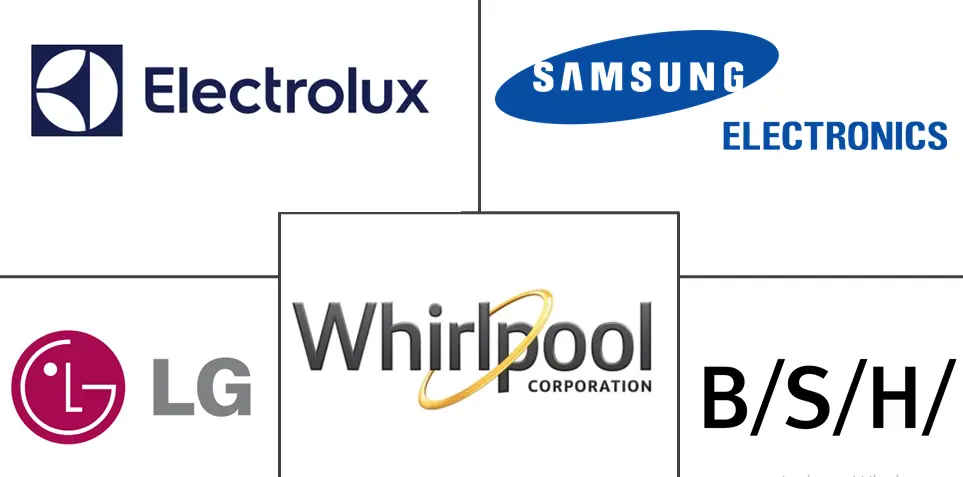
*Disclaimer: Major Players sorted in no particular order |
Smart Home Appliances Market Analysis
The Smart Home Appliances Market size is estimated at USD 34.98 billion in 2024, and is expected to reach USD 53.61 billion by 2029, growing at a CAGR of 8.91% during the forecast period (2024-2029).
The Internet of Things has expanded across smart home applications, and it is anticipated to become more configurable to provide users more control and improve how the appliances operate. Consumer Technology Association predicts that by 2022, connected home goods will bring in $5.94 billion in revenue in the United States.
- The next generation of traditional home appliances, known as "smart" appliances, are outfitted with advanced technologies for receiving, processing, and transmitting data using smartphones, tablets, and laptops. The U.S. Energy Information Administration projects that by 2035, the world's energy demand will have increased by almost 37%. The use of smart home appliances would rise in such a situation because they enable real-time communication to operate the gadget at low frequencies or move the operation time to off-peak hours. As a result, smart home appliances give both consumers and service providers enhanced control functions and greater comfort, security, and efficiency.
- Businesses in the market have been concentrating on improving food recognition and integrating it into kitchen applications like full-size ovens and refrigerators. A number of companies, including Bosch, GE, Samsung, and others, have been introducing concepts like a refrigerator that identifies and monitors food, remote monitoring of a stovetop, and integrating artificial intelligence (AI) into appliances for recommendations. Similar to this, smart home equipment for the kitchen is getting more functional upgrades, such as useful notifications, energy-saving appliances, and Wi-Fi capabilities. For instance, smart microwaves can now seamlessly download cooking instructions and read barcodes on food products while also offering AI voice assistants for a completely hands-free experience.
- Similar to this, the CES exhibition in 2021's smart home section had a number of small appliances. The allied smart kitchen gadgets included features that helped users increase cooking efficiency and precision, plan meals intelligently, improve their wellness, and streamline household tasks, among other things. Additionally, it is anticipated that machine vision and food inventory tracking systems will make an appearance in smart kitchen appliances to feature ingredient detection, food readiness, and recommendations in the form of the need to raise or lower the oven temperature or note any missing ingredients. However, smart appliances don't just improve food quality. Smart refrigerators, microwaves, ovens, and other appliances are being developed to help with waste reduction and energy monitoring by warning owners of problems in the kitchen, even when they are physically away from the house.
- Additionally, it has inspired makers of voice assistants to take things a step further by integrating cooking APIs into their platforms. This guarantees control over certain appliances by enabling voice capabilities for essential tasks like setting the cook's temperature and cooking food until it reaches a predetermined internal temperature. The function of the kitchen has changed as well, moving away from being just a place for food preparation and toward becoming a place for entertaining, mingling, dining, and working, among other things. Similar lifestyle adjustments have been made possible by technology. One of the major forces behind the adoption and development of smart and connectable appliances, for instance, is the design of appliances with additional functionality to make them easier to use. Additionally, rising interest in cooking over time has facilitated the growing acceptance.
- The COVID-19 outbreak temporarily reduced the Chinese home appliance industry's manufacturing capacity in the first half of 2020, but the market recovered its strength in the second half. As the people staying at home due to quarantine, the online retail channels experienced a tremendous increase in demand and contributed more than 70% of total revenues in the first quarter. Additionally, the Research Institute of the Ministry of Commerce of China predicted that the Chinese home appliance market would see a concentrated time of rejuvenation, with advantages for both smart and healthy home appliances.
Smart Home Appliances Market Trends
Smart Oven to Drive Significant Market Growth
- An electric oven that includes Wi-Fi or Bluetooth technology to link the appliance to a companion app for remote access is referred to as a smart oven. The app is made to provide a number of automatic oven tasks. The core operation of smart ovens is understood to be the same as that of conventional ovens.
- Most oven producers, including AEG, Bosch, and Samsung, presently offer a selection of smart ovens with corresponding apps to control specific parts of cooking. The philosophy behind it is to stay current with home automation market trends, which are encouraging home-cooked food with little time and effort, as with other household things.
- Several manufacturers have been investing in innovations, and new product launches with improved features to strengthen their position in the market. Additionally, a number of providers have taken part in alliances and acquisitions to strengthen their position in the market. For instance, Whirlpool stated in January 2022 that some of its smart, Wi-Fi-connected ovens would acquire an air fry mode via a software update to replicate the crispy reheating specifications of one of the internet's favorite cooking gadgets. The company's Smart Slide-in Gas and Electric Ranges and Smart Single, Double, and Combination Wall Ovens will both get the feature.
- Additionally, the scan-to-cook smart microwaves from Whirlpool's W Labs Countertop Smart Oven were discontinued by being sold for half of their original price. This action was linked to supply chain interruptions brought on by COVID-19 and an effort to get rid of inventory before launching a new line of smart ovens in 2021. Moreover, Tovala, the smart oven and meal kit business, closed a Series C of USD 30 million in February 2021. The company intends to utilize the funds primarily to build a second factory, most likely in Utah, to assist in distributing fresh foods to the western half of the country.
- As per Haier Smart Home, the total global retail sales of home and household appliances are forecast to surpass the 500 billion dollar mark by the year 2024. Major kitchen appliance sales take up one of the most significant shares of the market, with an overall retail sales of more than 87.9 billion U.S. dollars in 2021.
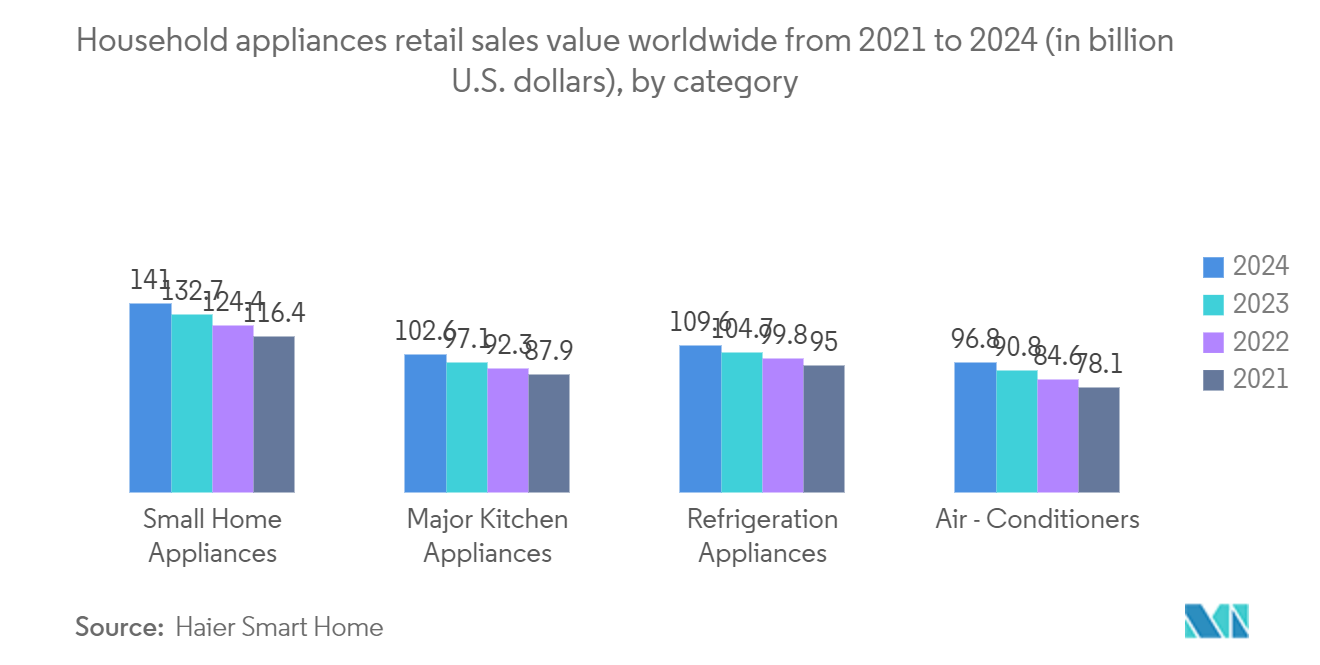
Asia-Pacific to Witness Highest Growth
- Due to factors like increased disposable income, dual-income households, and changing lifestyles, Chinese consumers now have access to AI-based smart home gadgets like robotic vacuum cleaners and smart refrigerators. The fact that China is one of the biggest marketplaces for home appliance items makes the country a desirable location for smart home appliances.
- The domestic appliance market in China has expanded into a multi-billion dollar industry. In the past ten years, China's per capita spending on high-tech home furnishings and consumer gadgets has surged. Models from the Organization for Economic Cooperation and Development (OECD) predict that by 2060, the income per person in China and India might have increased by seven times.
- Japan is one of the top investors in smart home appliance items in the area, second only to China. The study market is expanding as a result of increased investment in linked home devices and strong penetration of smart home appliances due to high awareness.
- All smart home products are being significantly disrupted by voice assistants and AI, and the market for smart home appliances has also seen remarkable growth in recent years. Robots that clean homes are gradually becoming a common reality in Japan. Now that AI-powered voice speakers are a thing of the past, customers are starting to welcome vacuum robots into their homes.
- In comparison to South Korea and India, marketplaces in places like Singapore, Hong Kong, etc., have a high penetration rate but are relatively small. In October 2021, Whirlpool Corp. announced its new W series of premium 4-door smart refrigerators in India in October 2021. The Quattro (4-Door) configuration is designed for ease of use and provides enough space for chilled demands in addition to the substantial 665L storage capacity.
- As per data from Haier Smart Home, the major household appliances retail unit volume would reach a landmark of USD 425.5 million units in Asia. Thus the rise in the overall number of retail sales of various smart home appliances would create enormous growth opportunities in the region throughout the forecasted time period.
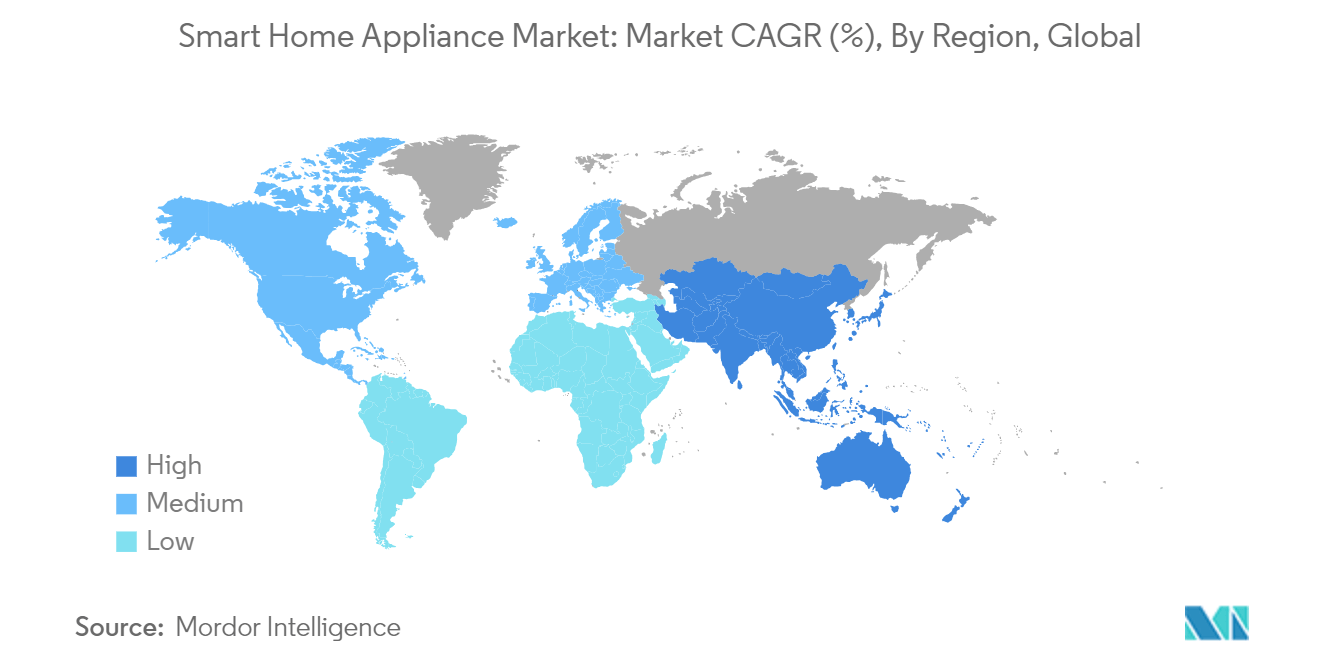
Smart Home Appliances Industry Overview
The market for smart home appliances is saturated. Mid-size and smaller businesses are expanding their market presence by gaining new contracts and tapping new markets due to technological improvements and product innovations. The following are a few significant market developments:
- October 2021 - Whirlpool Corp. unveiled its new W line of premium 4-door smart refrigerators in India. The Quattro (4-Door) arrangement is made for simplicity and offers enough room for chilled demands, coupled with the sizeable 665L storage area.
- October 2021 - Panasonic Corp. announced the release of 24 new washing machine models and 43 new refrigerator models, further increasing its home appliance market. The most recent models give customers more comfort and convenience in their daily lives due to their high-tech features.
Smart Home Appliances Market Leaders
-
LG Electronics Inc.
-
Electrolux Group
-
Whirlpool Corporation
-
Samsung Electronics Co. Ltd
-
BSH Home Appliances Corporation
*Disclaimer: Major Players sorted in no particular order
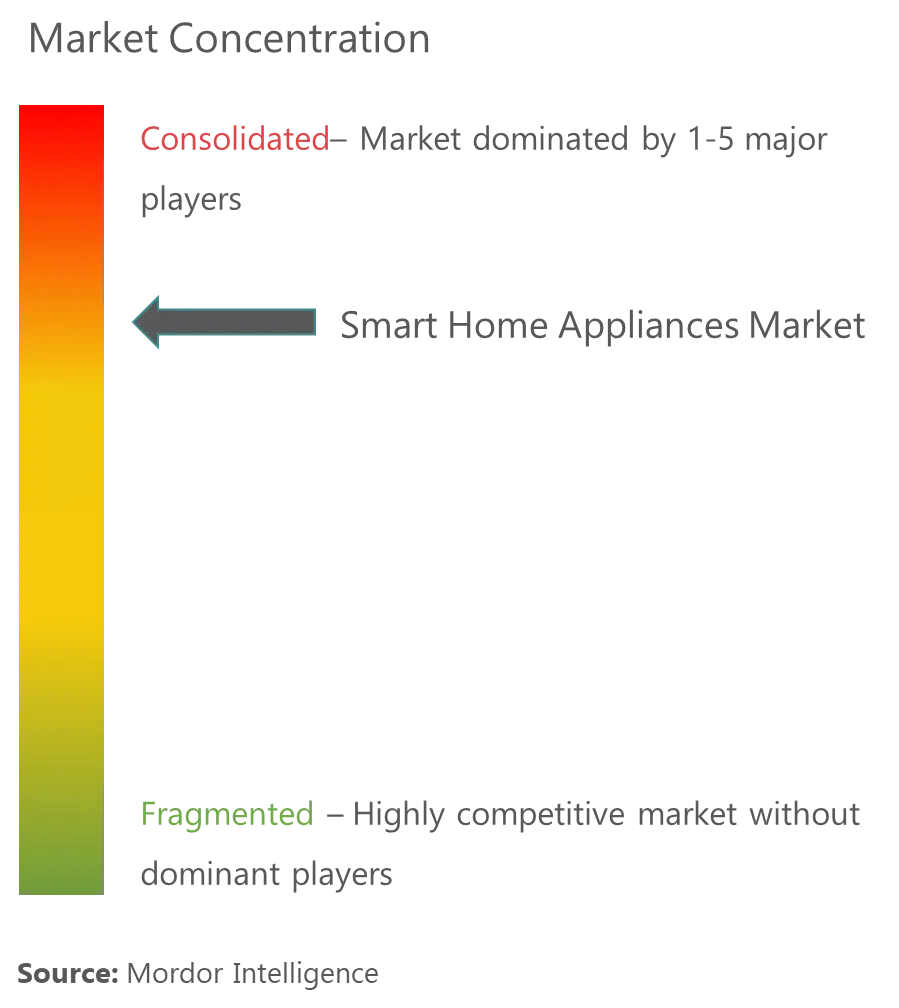
Smart Home Appliances Market News
- September 2022 - At IFA 2022 in Berlin, Germany, LG Electronics (LG) plans to introduce its ground-breaking refrigerator with MoodUP technology, which includes color-changing LED door panels. The new refrigerator skillfully bridges the borders between design and technology to serve younger consumers' changing needs better. With the help of LG's MoodUP technology, customers can design a unique lighting system for the refrigerator using a variety of brilliant colors to match their mood or the surroundings. In addition, users may use the device's built-in Bluetooth speaker to play music to set the mood in the kitchen, whether they are hosting a party or cooking for themselves.
- August 2022 - Enphase Energy, Inc., a leader in microinverter-based solar and battery systems and a global leader in energy technology, declared a new partnership with Home Connect. This open digital platform enables the management of multiple brands of home appliances through a single app. Enphase will connect its home energy systems with the Home Connect platform as part of the partnership, providing a smart, eco-friendly, and highly effective solution to power home appliances that support Home Connect. Enphase and Household Connect aim to make it simple for clients to set up home appliances that support Home Connect to run during solar energy production peaks, off-peak energy hours, or when energy prices are at their lowest.
- February 2022 - The flagship firm of the Godrej Group, Godrej & Boyce, has announced the launch of its line of luxury air conditioners from Godrej Appliances, which feature enhanced cooling, air purifying technology, IoT controls, distinctive aesthetics, and more. With IoT, UVCool technology, Nano Coated Anti-Viral filtering, decreased derating, and other technologies, these air conditioners offer smart controls to more tech-savvy consumers in addition to comfort and safety.
Smart Home Appliances Market Report - Table of Contents
1. INTRODUCTION
- 1.1 Study Assumptions and Market Definition
- 1.2 Scope of the Study
2. RESEARCH METHODOLOGY
3. EXECUTIVE SUMMARY
4. MARKET INSIGHTS
- 4.1 Market Overview
-
4.2 Industry Attractiveness - Porter's Five Forces Analysis
- 4.2.1 Bargaining Power of Suppliers
- 4.2.2 Bargaining Power of Consumers
- 4.2.3 Threat of New Entrants
- 4.2.4 Threat of Substitutes
- 4.2.5 Intensity of Competitive Rivalry
- 4.3 Assessment of the COVID-19 Impact on the Industry
5. MARKET DYNAMICS
-
5.1 Market Drivers
- 5.1.1 Growing Household Income Combined with Increased Awareness among Consumers
-
5.2 Market Challenges
- 5.2.1 High Product Costs, Product Lifespan, and Security Concerns
6. MARKET SEGMENTATION
-
6.1 By Product Type
- 6.1.1 Smart Ovens
- 6.1.2 Smart Dishwashers
- 6.1.3 Smart Refrigerators
- 6.1.4 Smart Cookware and Cooktops
- 6.1.5 Smart Scale and Thermometers
- 6.1.6 Other Product Types
-
6.2 By Geography***
- 6.2.1 North America
- 6.2.1.1 United States
- 6.2.1.2 Canada
- 6.2.2 Europe
- 6.2.2.1 Germany
- 6.2.2.2 United Kingdom
- 6.2.2.3 France
- 6.2.2.4 Spain
- 6.2.3 Asia
- 6.2.3.1 China
- 6.2.3.2 Japan
- 6.2.4 Australia and New Zealand
- 6.2.5 Latin America
- 6.2.6 Middle East and Africa
7. COMPETITIVE LANDSCAPE
-
7.1 Company Profiles*
- 7.1.1 AB Electrolux
- 7.1.2 Samsung Electronics Co. Ltd
- 7.1.3 Whirlpool Corporation
- 7.1.4 LG Electronics Inc.
- 7.1.5 BSH Home Appliances Corporation
- 7.1.6 Panasonic Corporation
- 7.1.7 Haier Group
- 7.1.8 Breville Group Limited
8. INVESTMENT ANALYSIS
9. FUTURE OF THE MARKET
** Subject To AvailablitySmart Home Appliances Industry Segmentation
The paper examines the present market environment and significant factors affecting smart home equipment and gadgets. The study's scope includes gadgets that can be connected to a network and controlled from a distance, like tablets and smartphones. The study's scope contains appliances, including ovens, dishwashers, refrigerators, cooktops and cookware, scales, thermometers, and other items. The paper discusses the market trends in particular North American, European, and Asia-Pacific countries.
The smart home appliance market report is segmented by product type (smart ovens, smart dishwashers, smart refrigerators, smart cookware and cooktops, smart scale and thermometers), and geography (North America (United States, Canada), Europe (Germany, United Kingdom, France, Spain), Asia Pacific, and the Rest of the World). The market sizes and forecasts are provided in terms of value (USD) for all the above segments.
| By Product Type | Smart Ovens | |
| Smart Dishwashers | ||
| Smart Refrigerators | ||
| Smart Cookware and Cooktops | ||
| Smart Scale and Thermometers | ||
| Other Product Types | ||
| By Geography*** | North America | United States |
| Canada | ||
| By Geography*** | Europe | Germany |
| United Kingdom | ||
| France | ||
| Spain | ||
| By Geography*** | Asia | China |
| Japan | ||
| By Geography*** | Australia and New Zealand | |
| Latin America | ||
| Middle East and Africa |
Smart Home Appliances Market Research FAQs
How big is the Smart Home Appliances Market?
The Smart Home Appliances Market size is expected to reach USD 34.98 billion in 2024 and grow at a CAGR of 8.91% to reach USD 53.61 billion by 2029.
What is the current Smart Home Appliances Market size?
In 2024, the Smart Home Appliances Market size is expected to reach USD 34.98 billion.
Who are the key players in Smart Home Appliances Market?
LG Electronics Inc., Electrolux Group, Whirlpool Corporation, Samsung Electronics Co. Ltd and BSH Home Appliances Corporation are the major companies operating in the Smart Home Appliances Market.
Which is the fastest growing region in Smart Home Appliances Market?
Asia Pacific is estimated to grow at the highest CAGR over the forecast period (2024-2029).
Which region has the biggest share in Smart Home Appliances Market?
In 2024, the North America accounts for the largest market share in Smart Home Appliances Market.
What years does this Smart Home Appliances Market cover, and what was the market size in 2023?
In 2023, the Smart Home Appliances Market size was estimated at USD 31.86 billion. The report covers the Smart Home Appliances Market historical market size for years: 2019, 2020, 2021, 2022 and 2023. The report also forecasts the Smart Home Appliances Market size for years: 2024, 2025, 2026, 2027, 2028 and 2029.
Smart Home Appliances Industry Report
Statistics for the 2024 Smart Home Appliances market share, size and revenue growth rate, created by Mordor Intelligence™ Industry Reports. Smart Home Appliances analysis includes a market forecast outlook to 2029 and historical overview. Get a sample of this industry analysis as a free report PDF download.



